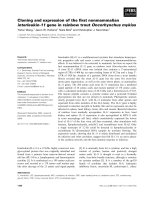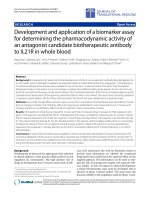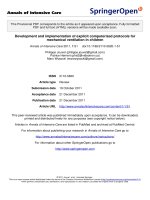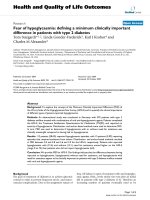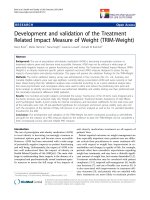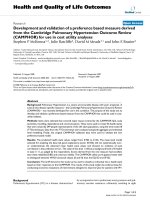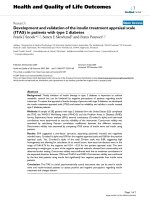báo cáo hóa học: " Development and validation of the insulin treatment appraisal scale (ITAS) in patients with type 2 diabetes" docx
Bạn đang xem bản rút gọn của tài liệu. Xem và tải ngay bản đầy đủ của tài liệu tại đây (254.26 KB, 7 trang )
BioMed Central
Page 1 of 7
(page number not for citation purposes)
Health and Quality of Life Outcomes
Open Access
Research
Development and validation of the insulin treatment appraisal scale
(ITAS) in patients with type 2 diabetes
Frank J Snoek*
1,2
, Søren E Skovlund
3
and Frans Pouwer
1,2
Address:
1
Department of Medical Psychology, VU University Medical Center Amsterdam, The Netherlands,
2
EMGO Institute, VU University
Medical Center Amsterdam, The Netherlands and
3
Novo Nordisk A/S, DAWN, Bagsvaerd, Denmark
Email: Frank J Snoek* - ; Søren E Skovlund - ; Frans Pouwer -
* Corresponding author
Abstract
Background: Timely initiation of insulin therapy in type 2 diabetes is important to achieve
metabolic control but can be hindered by negative perceptions of patients regarding insulin
treatment. To assess the appraisal of insulin therapy of persons with type 2 diabetes, we developed
the insulin treatment appraisal scale (ITAS) and tested its reliability and validity in insulin treated
type 2 diabetes patients.
Methods: A sample of 282 patients with type 2 diabetes form the United States (US) completed
the ITAS, the WHO-5 Well-being index (WHO-5) and the Problem Areas in Diabetes (PAID)
Survey. Exploratory factor analysis (EFA), internal consistency (Cronbach's alpha) and item-total
correlations were determined to test the reliability of the instrument. Concurrent validity was
examined by calculating Pearson correlation coefficients between the different measures.
Discriminant validity was examined by comparing ITAS scores of insulin naive and insulin using
patients.
Results: EFA suggested a two-factor structure, separating positively worded and negatively
worded items. Cronbach's alpha was 0.90 for the negative appraisal scale and 0.68 for the positive
appraisal scale. Yet, Cronbach's alpha of the total 20-item scale was 0.89, suggesting high
homogeneity and allowing for calculation of an overall score. Item-total correlations were in the
range of 0.46–0.74 for the negative and 0.34 – 0.53 for the positive appraisal scale. The item
pertaining to weight gain, as part of the negative appraisal subscale, showed low communality and
deserves further testing. Concurrent validity was confirmed with low to moderate correlations in
the expected direction between ITAS and WHO-5 and PAID. Discriminant validity was confirmed
by the fact that patients using insulin had significantly less negative appraisals than insulin naive
patients.
Conclusion: The ITAS is a brief, psychometrically sound instrument that can be used in insulin
naive and insulin-treated patients to assess positive and negative perceptions regarding insulin
treatment and changes therein.
Published: 20 December 2007
Health and Quality of Life Outcomes 2007, 5:69 doi:10.1186/1477-7525-5-69
Received: 18 July 2007
Accepted: 20 December 2007
This article is available from: />© 2007 Snoek et al; licensee BioMed Central Ltd.
This is an Open Access article distributed under the terms of the Creative Commons Attribution License ( />),
which permits unrestricted use, distribution, and reproduction in any medium, provided the original work is properly cited.
Health and Quality of Life Outcomes 2007, 5:69 />Page 2 of 7
(page number not for citation purposes)
Backgound
It is well recognized that intensive treatment can help to
delay the onset of diabetes-related complications [1] and
that many patients with type 2 diabetes require insulin
therapy at some stage to achieve or maintain good glycae-
mic control [2]. In clinical practice however, initiation of
insulin therapy is often delayed due to a variety of rea-
sons, including patients' reluctance to accept insulin ther-
apy [3,4]. The latter has been referred to in the literature
as 'psychological insulin resistance' [5,6] a problem that
was shown to be common among patients with type 2
diabetes in need of more intensive treatment [7,8].
Patients' reluctance to start insulin was found to be asso-
ciated most strongly with the belief that starting insulin
would indicate they had 'failed' to adequately self-manage
their diabetes, next to fears about social stigma, perceiving
insulin therapy as burdensome and too complex, worries
about painful injections, the risk of hypoglycemia and
anticipated weight gain [7-9]. To assist health care profes-
sionals and researchers in assessing barriers to timely
insulin initiation and explore patients' attitudes towards
insulin therapy, a short, comprehensive tool would be
helpful. Moreover, such a measure would also be useful to
prospectively measure changes in the patient's appraisals
of insulin therapy in due course. For these purposes we
developed the insulin treatment appraisal scale (ITAS), a
20-item self-report measure pertaining to both negative
and positive beliefs regarding insulin treatment (see Addi-
tional file 1). Here we report on the development and
validity of the ITAS.
Methods
Development of ITAS
The ITAS was developed to capture type 2 diabetes
patient's current appraisal of insulin therapy. The instru-
ment assesses both positive and negative attitudes. The
respondent is asked to indicate on a 5-point Likert scale to
what extent he or she agrees with each statement, from
"strongly disagree to " strongly agree". Twenty potential
items for the scale were generated from the literature on
patients' barriers to staring insulin [8,9], discussions with
diabetes care providers and clinical encounters with insu-
lin naïve as well as insulin treated patients. The authors
reached consensus on 4 positive and 16 negative state-
ments (See Additional File 1). The ITAS was conceptual-
ized as a two-dimensional instrument, with "appraisal of
insulin therapy" as a single underlying construct, allowing
for calculating a total score and two subscale scores. The
ITAS has been designed as a diagnostic tool as well as an
evaluation instrument to track changes in perceptions
regarding insulin therapy over time.
Patients
This validation study was conducted as part of a larger
web-based survey on the impact of diabetes on treatment
satisfaction, productivity and symptom experience con-
ducted in the United States (US). The aims and method-
ology of this study were reported in detail by Brod et al.
[10]. Briefly, participants were recruited from the Harris
Interactive Chronic Illness Panel consisting of over 25,000
people with diabetes in the US who are considered a rep-
resentative sample based on key characteristics for this
population. From a total of 991 respondents who gave
consent to receive the survey online, 282 type 2 diabetes
patients participated in this sub-study (response-rate
29%), 146 insulin-naïve and 136 insulin-treated. The
patient sample was obtained by use of quotas, i.e. recruit-
ment was continued until there were equal number of
insulin naïve and insulin-using patients. On average, the
length of time since diabetes diagnosis of this sample was
5.1 years (SD 1.1, range 1–6).
Measures
Socio-demographic and clinical data were self-reported as
part of the online survey, using a short questionnaire. To
ascertain the concurrent validity of the ITAS, patients were
asked to fill in two validated and widely used psychologi-
cal measures: the Problem Areas In Diabetes (PAID) scale
and the World Health Organization Five Item Well-Being
Index (WHO-5).
The PAID is a well validated and widely-used 20 items
self-report scale to assess the current level of diabetes-
related emotional distress both in type 1 and type 2 diabe-
tes [11-13]. PAID items contain commonly expressed neg-
ative emotions related to living with diabetes (e.g.
worrying about hypoglycemia, feeling burned out by the
daily efforts to manage the diabetes, feeling worried about
the future and complications) that are rated on a Likert
scale ranging from 0 (not a problem) to 4 (a serious prob-
lem); scores are summed and standardized to a 0–100
scale, with higher scores indicating higher emotional dis-
tress.
The World Health Organization Five Item Well-Being
index (WHO-5) is a uni-dimensional measure of emo-
tional well-being containing five positively worded items
[14]. The respondent is asked to indicate the degree to
which these positive feelings were present in the last two
weeks on a 6-point Likert scale, ranging from 0 (not
present) to 5 (constantly present). Summation of the
items scores provides a total score, which is standardized
to a 0–100 scale. A higher score represents better emo-
tional well-being. The WHO-5 has proven tot be a highly
sensitive screener for depression in adults with and with-
out diabetes [15,16].
Statistical analysis
SPSS version 12.01 for Windows was used to analyse the
data. Descriptive statistics were applied to calculate fre-
Health and Quality of Life Outcomes 2007, 5:69 />Page 3 of 7
(page number not for citation purposes)
quencies, means and standard deviation on all measures.
Differences in demographic, clinical and questionnaire
scores between the insulin naïve and insulin-treated
group were tested using χ
2
tests to compare categorical
data, and the Student's t-test or the Mann-Whitney U test
for continuous data. Statistical significance was set at p <
0.05. Explorative factor analysis with Oblimin rotation
was performed on the 20 ITAS items. An oblique rotation
method was chosen because we anticipated that the fac-
tors would be correlated. The knick-criterion and the Kai-
ser-criterion (Eigenvalue > 1) were used to determine the
optimal number of factors [17]. Next, the scree plot of the
Eigenvalues was used to determine the optimal number of
factors. Items with loadings exceeding 0.40 on one factor
and less than 0.30 on any other factor are generally
regarded as items with good scaling properties.
To assess the homogeneity of the retrieved scale(s), we cal-
culated communalities, Cronbach's alpha, item-total cor-
relations and inter-item correlations. For internal
consistency, an alpha of 0.70–0.80 is desirable and the
item-total correlation should be above 0.20. A high inter-
item correlation (> 0.80) is often an indication of redun-
dancy. Pearson correlations between total ITAS, PAID and
WHO-5 scores were calculated as an indication for con-
current validity. It was hypothesized that PAID (emo-
tional distress) would show a moderate positive
association with negative appraisal of insulin therapy (r =
0.30–0.50). Lower WHO-5 scores (worse emotional well-
being) were expected to be moderately associated with
more negative appraisal of insulin therapy. Discriminant
or known-groups validity was explored by comparing
mean ITAS scores of insulin naïve versus insulin treated
diabetes patients, expecting the latter group to report less
negative appraisal, i.e. lower mean ITAS scores.
Results
Complete questionnaires were available from 282 type 2
diabetes, of whom 136 (48%) were insulin treated. Self-
reported characteristics of the male and female respond-
ents are displayed in Table 1. Mean age in the total sample
was 59 ± 11 years, 54% were female, mean HbA
1c
was 6.8
± 1.8 and participants had a mean diabetes duration of 5
± 1 years. Furthermore, the insulin naïve participants had
a similar socio-demographic profile and ethnicity com-
pared to subjects who were insulin-treated, but had a
shorter disease duration (4.2 years versus 5.3 years, p <
0.001) and less often complications: cardiovascular dis-
ease (47% versus 57%, p < 0.05), eye/vision problems
(21% versus 36%, p < 0.05) kidney problems (7% versus
11%, n.s.) and loss of feeling in hands or feet (21% versus
40%, P < 0.001). Not unexpectedly, Body Mass Index was
significantly higher in patients who were treated with
insulin, compared to the diet/tablet treated patients (33
vs. 36 kg/m
2
, p < 0.01).
Factor analyses
Exploratory factor analyses (EFA) revealed 4 factors with
an Eigenvalue >1. The first four Eigenvalues were 6.9, 2.2,
1.3 and 1.1. Using the knick-criterium, the drop in Eigen-
values after 6.9 and the "knick" in the plot after the second
Eigenvalue suggests a uni-dimensional or 2-dimensional
factor structure of the ITAS. In the unrotated 1 factor struc-
ture, the four positively worded items and the ITAS item
on weigh gain had low communalities, ranging from
0.004 to 0.042. Using the Kaiser criterion, a maximum of
4 factors should be generated. Therefore, we calculated the
2-, 3- and 4-factor solutions for the ITAS using Oblimin
oblique rotation (Table 2). The 2-factor structure con-
sisted of 19 items: 15 negatively worded items loaded
mainly on a first factor (F2.1) while the 4 positively
worded loaded only on the second factor (F2.2). The
"weight gain-item" had a very low communality (0.03)
and did not load substantially on either of the two factors.
This solution explained 45% of the total variance. Corre-
lation between both factors was -0.04.
In the 3-factor solution, all items had loadings > 0.40, yet
7 negatively worded items loaded on two factors. The 4-
factor solution also included all 20 items, explaining 57%
of the total variance. Like the 3-factor solution, this 4-fac-
Table 1: Self-reported demographic and clinical characteristics of
the insulin naïve and insulin treated participants. * p < 0.05; ** p <
0.01; *** p < 0.001
Insulin naïve Insulin-treated
n (%) 146 (52%) 136 (48%)
Male sex 46% (67/146) 46% (63/136)
Living alone 31% (45/146) 24% (32/136)
White (Caucasian) 94% (135/144) 90% (120/133)
Age (years)
30–49 19% (27/146) 27% (37/136)
50–64 38% (55/146) 34% (46/136)
65 or older 44% (64/146) 39% (53/136)
BMI 33 ± 7 36 ± 9 **
Highest education
< high school 3% (4/146) 2% (2/136)
High school/GED 49% (72/146) 52% (70/136)
College degree 33% (48/146) 32% (43/136)
≥ Graduate degree 15% (22/146) 15% (21/136)
Treatment for type 2 diabetes
oral medication 94% (137/146) 56% (76/136)***
insulin pump - 2% (3/136)
HbA
1c
6.5 ± 2.1 (n = 38) 6.9 ± 1.6 (n = 53)
Duration of diabetes (years) 4.2 ± 1.2 5.3 ± 0.8
Diabetes complications
Retinopathy 21% (30/146) 36% (49/136)**
Cardiovascular 47% (68/146) 57% (77/136)
Nephropathy 7% (10/146) 11% (15/136)
Neuropathy 21% (31/146) 40% (55/136)***
Mean PAID total score 22 ± 22 30 ± 23 ***
Mean WHO-5 19 ± 5 18 ± 6**
Health and Quality of Life Outcomes 2007, 5:69 />Page 4 of 7
(page number not for citation purposes)
tor solution showed many items loading on more than 1
scale. Ten items had double loadings and two items
loaded on three factors.
The 2-factor solution would appear the best representa-
tion of the latent structure of the ITAS, given that all items
had high communalities, except item 9 (insulin causes
weight gain) and all positively worded items consistently
loaded on one factor.
Internal consistency
Cronbach's alpha was 0.89 for the 20-item scale, 0.90 for
the 16-item negatively worded scale and 0.68 for the 4-
item positively worded ITAS scale, indicating satisfactory
homogeneity.
For the positive scale item-total correlations range from
0.34 to 0.53. In the negative scale, the item 'insulin causes
weight gain' showed a low item-total correlation (0.10),
while the remaining item-total correlations were in the
range of 0.46 to 0.74.
Concurrent validity
Pearson correlations between ITAS total (with positive
scores reversed) and PAID (emotional distress) and
WHO-5 (well-being) were 0.35 (p < 0.05) and -0.14 (p <
0.05) respectively, confirming low to moderate correla-
tions in the expected direction. Higher ITAS scores (more
negative appraisal) tend to go hand in hand with higher
diabetes-related distress and lower emotional well-being.
Additional analyses showed a comparable pattern of cor-
relations with subscales: an association of 0.33 (p <
0.001) and -0.12 (p < 0.04) between ITAS-negative and
PAID and WHO-5 respectively. For the positively worded
ITAS subscale, correlations were -0.21 (P < 0.001) with
PAID and 0.13 (p < 0.025) with the WHO-5.
Discriminant validity
Mean scores and percentages of subjects who responded
with 'agree' or 'strongly agree' to each of the 20 ITAS items
are shown in Table 3, for insulin-naïve and insulin-treated
patients. The mean total ITAS score of the insulin-naïve
patients was about one standard deviation higher com-
pared to insulin-treated patients (61.6 ± 12.8 vs. 48.9 ±
11.2, p < 0.001). Insulin-naïve patients reported signifi-
cantly higher scores for all 16 negative items compared to
insulin-treated, with the exception of the item pertaining
to weight. Here 54% of the insulin-treated agreed that
insulin causes weight gain, compared to 23% in the insu-
lin naïve. The highest mean score for insulin-naïve
patients was on the item pertaining to the belief that insu-
lin signifies disease progression (item 2). Highest mean
scores of the insulin-treated patients are on three of the
four positive items (3, 8 and 17) pertaining to improved
Table 2: Exploratory factor analyses of the 20 items of the ITAS: forced 2-, 3- and 4-factor solution after Oblimin rotation. Only factor
loading > 0.40 are shown; h
2
: communality.
2-factor solution: 3-factor solution 4-factor solution
h
2
F1/2 F2/2 h
2
F1/3 F2/3 F3/3 h
2
F1/4 F2/4 F3/4 F4/4
Item content:
1. Failed on pre-insulin therapy 0.34 0.59 0.53 0.45 0.67 0.71 0.82
2. Diabetes has gotten worse 0.50 0.70 0.63 0.57 0.70 0.74 0.45 0.86
3. Prevent complications 0.49 0.70 0.53 0.72 0.53 0.72
4. Perceived by others as more sick 0.51 0.71 0.57 0.61 0.62 0.60 0.52 0.75
5. Life less flexible 0.51 0.70 0.51 0.60 0.44 0.60 0.64
6. Fear of injecting with needle 0.40 0.62 0.52 0.70 0.52 0.70
7. Risk of hypoglycaemia 0.28 0.52 0.28 0.48 0.39 0.50 0.44
8. Improves health 0.59 0.77 0.64 0.79 0.65 0.79
9. Causes weight gain 0.03 - - 0.33 0.60 0.80 0.88
10. Takes time and energy 0.50 0.70 0.58 0.74 0.58 0.74 0.46
11. Give up activities I enjoy 0.58 0.70 0.58 0.68 0.58 0.65 0.57
12. My health will deteriorate 0.56 0.71 0.58 0.66 0.49 0.62 0.64 0.57 0.41
13. Injecting is embarrassing 0.53 0.70 0.57 0.73 0.57 0.72 0.49
14. Injecting is painful 0.41 0.64 0.55 0.72 0.61 0.76
15. Difficult to always inject correctly 0.49 0.70 0.58 0.76 0.59 0.77 0.41
16. Difficult to fulfil responsibilities 0.67 0.80 0.71 0.82 0.71 0.81 0.56
17. Helps to control blood glucose 0.55 0.74 0.56 0.73 0.56 0.72
18. Family/friends more concerned 0.39 0.59 0.44 0.49 0.56 0.46 0.45 0.55 0.44
19. Helps to improve energy levels 0.28 0.53 0.28 0.53 0.29 0.53
20. More dependent on doctor 0.47 0.67 0.48 0.62 0.47 0.49 0.56 0.63
Explained variance: 45% 52% 57%
Health and Quality of Life Outcomes 2007, 5:69 />Page 5 of 7
(page number not for citation purposes)
prognosis, improvement of health and good control of
blood glucose, with 82%, 78% and 73% 'agree' to
'strongly agree' respectively. As to the item 'insulin helps
to improve my energy levels' (item 19) both insulin-naïve
and insulin-treated report relatively low agreement (25
and 35% respectively). The difference in responses to neg-
ative items between both groups is most striking on item
6 (fear of needle injections) where only 6% of the insulin-
treated agrees to fearing injections compared to 47% of
the insulin-naïve participants.
Discussion
The findings from this study confirm good psychometric
properties of the 20-item insulin treatment appraisal scale
(ITAS) in both insulin naïve and insulin-treated type 2
diabetes patients. Factor analyses suggest a simple two-
factor structure, with items pertaining to a positive and a
negative appraisal of insulin. The internal consistency is
high, suggesting the positive and the negative items relate
to one underlying construct, namely a person's current
appraisal of insulin therapy. Correlations between ITAS
and PAID scale (diabetes-distress) were significant and in
the expected direction, confirming concurrent validity.
The linear association between ITAS and WHO-5 (well-
being) was significant, but lower than expected. Interest-
ingly, post-hoc analyses revealed that both among the
insulin treated as well as the insulin-naïve patients, a
WHO-5 score indicative of clinical depression (< 28) was
associated with a significantly higher score on the ITAS
(52.9 vs. 48.0, p = 0.046 and 65.5 vs. 60.9, p = 0.14 respec-
tively). This finding is in concert with a recent study in
Turkish insulin-naïve patients with type 2 diabetes where
we found that symptoms of depression were positively
associated with a more negative appraisal of insulin ther-
apy [18]. Further research into the role of negative affect
in patients' perceptions of insulin therapy is warranted, as
depression is common among people with type 2 diabe-
tes, adversely affecting self-management and subsequent
clinical outcomes [19].
Data from this sample of US type 2 diabetes revealed
some interesting differences between insulin-naïve and
insulin-treated patients, suggesting a trend towards a less
negative appraisal of insulin therapy in those who actually
are on insulin treatment. The drop in fear of injections
from 47% agreeing to 6% (mean score change from 3.1
to1.4) is most striking. Yet, still 36% of the insulin-treated
patients agree to the item that injecting insulin is painful,
compared to 43% in the insulin-naïve group. This sug-
gests that despite improved injection devices and thinner
Table 3: Item content, mean scores and distribution of responses to individual items comparing insulin-naïve versus insulin treated
participants and mean subscale and total ITAS scores. * p < 0.05; ** p < 0.01; *** p < 0.001.
Insulin naïve (n = 146) Insulin-treated (n = 136)
Mean (SD) agree or strongly agree Mean (SD) agree or strongly agree
1. Insulin signifies failure with pre-insulin therapy 3.4 ± 1.4 54% 2.5 ± 1.4*** 27%***
2. Insulin signifies diabetes has worsened 3.9 ± 1.6 73% 2.8 ± 1.3*** 37%***
3. Insulin will improve prognosis 3.8 ± 1.1 62% 4.2 ± 1.0*** 82%***
4. Insulin will make others perceive greater sickness 3.2 ± 1.3 41% 2.5 ± 1.2*** 20%***
5. Insulin will make life less flexible 3.8 ± 1.1 70% 2.9 ± 1.3*** 40%***
6. Fear of needle injection 3.1 ± 1.5 47% 1.4 ± 1.0*** 6%***
7. Insulin will increase the risk of hypoglycaemia 3.1 ± 1.1 52% 3.0 ± 1.3*** 40%***
8. Insulin will improve health 3.6 ± 1.0 53% 4.0 ± 1.0*** 78%***
9. Insulin will cause weight gain 3.1 ± 0.9 23% 3.6 ± 1.3*** 54%***
10. Insulin will be demanding to administer 3.6 ± 1.1 61% 2.7 ± 1.2*** 28%***
11. Insulin means I have to give up activities I enjoy 2.6 ± 1.1 19% 1.9 ± 1.1*** 10%***
12. Insulin means my health will deteriorate 2.7 ± 1.1 23% 2.2 ± 1.1*** 13%***
13. Injecting insulin is embarrassing 2.6 ± 1.3 23% 1.8 ± 1.3*** 10%***
14. Injecting insulin is painful. 3.3 ± 1.2 43% 2.7 ± 1.3*** 38%**
15. It is difficult to always inject insulin correctly 3.2 ± 1.2 40% 2.3 ± 1.3*** 26%***
16. Insulin makes it difficult to fulfil my responsibilities 2.9 ± 1.2 27% 1.9 ± 1.1*** 9%***
17 Insulin helps to maintain good control of blood glucose 3.7 ± 1.0 59% 4.0 ± 1.1* 73%***
18. Using insulin causes family/friends to be more concerned 3.5 ± 1.1 55% 3.1 ± 1.3*** 46%**
19. Insulin helps to improve my energy levels 3.2 ± 0.7 25% 3.1 ± 1.1 NS 35%***
20. Insulin makes me more dependent on my doctor 3.4 ± 1.1 40% 3.0 ± 1.2*** 35%***
Mean Total Negative items ITAS 55.5 ± 12.7 44.1 ± 10.0***
Mean Total Positive items ITAS 14.3 ± 2.9 15.2 ± 2.8*
Mean Total ITAS (sum score 20 items, 4 negative recoded) 61.6 ± 12.8 48.9 ± 11.2***
Health and Quality of Life Outcomes 2007, 5:69 />Page 6 of 7
(page number not for citation purposes)
needles, the daily injections are experienced as painful by
a substantial number of patients. Prospective studies are
warranted to determine the extent to which attitudinal
changes towards insulin therapy occur in type 2 diabetes
patients after insulin initiation.
Some limitations of this study need to be mentioned.
First, the response rate in this cross-sectional study was
rather low (29%) and may have influenced the results.
Second, only persons with diabetes willing to complete
the on-line surveys, with less than 10% of ethnic back-
ground, were included which may have further biased the
outcomes. Future studies on the psychometric properties
of the ITAS should include larger and more diverse sam-
ples of type 2 diabetes patients. This should also help to
clarify the problem of low communality found for the
item on weight gain in both insulin using and insulin
naïve patients. The item apparently does not fit well in the
scale and could be considered for deletion. However,
Cronbach's alpha was not significantly improved when
this particular item was removed, and the topic of weight
gain is generally acknowledged as one of the important
barriers in the current treatment of type 2 diabetes [20].
We therefore suggest to retain item 9 in the ITAS, deserv-
ing special attention. Interestingly, only 23% of the insu-
lin-naïve patients agreed that insulin leads to weight gain,
compared to 54% of the insulin-treated patients. Addi-
tional analyses showed that the answer "neither agree nor
disagree" was the most common response (63%) in the
insulin-naïve group, suggesting no clear view on the mat-
ter. In the insulin-treated group, however, only 27%
responded neutral. Insulin-treated patients indeed had a
significantly higher BMI, compared to insulin-naïve
patients. Sixty % of the subjects with a BMI over 30
(obese) agreed that insulin use is associated with weight
gain, compared to only 14–45% in the group of insulin
users with a BMI lower than 30. These data suggest that
weight gain as a result of insulin treatment is particularly
an issue for those who already are overweight.
Conclusion
The results from this study suggest that the ITAS is a valid
self-report instrument that would seem useful in people
with type 2 diabetes who have difficulty accepting insulin
treatment. Examination and discussion of ITAS scores in
clinical care can help to tailor education and treatment to
the patient's needs. Also, the instrument has potential to
assess changes in the appraisal of insulin over time, both
in individuals and groups. Future research should estab-
lish its test-retest reliability and responsiveness.
Abbreviations
BMI Body Mass Index
EFA Exploratory Factor Analysis
ITAS Insulin Treatment Appraisal Scale
PAID Problem Areas In Diabetes scale
WHO-5 World Health Organisation Five item Well-being
Index
Competing interests
This study was supported with an unrestricted grant from
Novo Nordisk. FJS has received honoraria from Novo
Nordisk for advisory services and non-commercial lec-
tures. FP has received conference expenses from Novo
Nordisk. SES is an employee of Novo Nordisk.
Authors' contributions
SES participated in the conceptualisation and design of
the original web-based survey. FJS, SES and FP assessed
the quality of the data collected and participated in the
design of the validation study and the development of the
statistical plan. FP carried out the statistical analyses. All
authors participated in the data interpretation. FJS drafted
the manuscript to which SES and FP made significant con-
tributions. All authors approved the manuscript submit-
ted for publication.
Additional material
Acknowledgements
The authors thank dr Meryl Brod for conducting the online survey that
included the ITAS, and the participants for their willingness to fill out the
questionnaires.
References
1. Turner RC, Cull CA, Frighi V, Holman RR: UK Prospective Diabe-
tes Study (UKPDS) group. Glycemic control with diet,
sulphonylurea, metformin, or insulin in patients with type 2
diabetes mellitus: progressive requirement for multiple
therapies (UKPDS49). JAMA 2012, 281:2005-1999.
2. Chan JL, Abrahamson MJ: Pharmacological management of type
2 diabetes mellitus: rationale for rational use of insulin. Mayo
Clin Proc 2003, 78:459-467.
3. Wallace TM, Matthews DR: Poor glycaemic control in type 2
diabetes: a conspiracy of disease, suboptimal therapy and
attitude. Q J Med 2000, 93:369-374.
4. Korytkoski M: When oral agents fail: practical barriers to
starting insulin. Int J Obes Relat Metab Disord 2002, 26:S18-S24.
5. Leslie CA, Satin-Rapaport W, Matheson D, Stone R, Enfield G: Psy-
chological insulin resistance: a missed diagnosis? Diabetes
Spectrum 1994, 7(1):52-57.
6. Hunt LM, Valenzuela MA, Pugh JA: NIDDM patients' fears and
hopes about insulin therapy: the basis for patient reluctance.
Diabetes Care 1997, 20:291-298.
Additional file 1
Insulin Treatment Appraisal Scale (ITAS)
Click here for file
[ />7525-5-69-S1.pdf]
Publish with BioMed Central and every
scientist can read your work free of charge
"BioMed Central will be the most significant development for
disseminating the results of biomedical research in our lifetime."
Sir Paul Nurse, Cancer Research UK
Your research papers will be:
available free of charge to the entire biomedical community
peer reviewed and published immediately upon acceptance
cited in PubMed and archived on PubMed Central
yours — you keep the copyright
Submit your manuscript here:
/>BioMedcentral
Health and Quality of Life Outcomes 2007, 5:69 />Page 7 of 7
(page number not for citation purposes)
7. Peyrot M, Rubin R, Lauritzen T, Skovlund SE, Snoek FJ, Matthews DR,
Landgraf R, Kleinebreil L: Resistance to insulin therapy among
patients and providers. Results of the cross-national Atti-
tudes, Wishes and Needs (DAWN) study. Diabetes Care 2005,
28:2673-2679.
8. Polonsky WH: Psychological insulin resistance in patients with
type 2 diabetes. The scope of the problem. Diabetes Care 2005,
28:2543-2545.
9. Meece J: Dispelling myths and removing barriers about insulin
in type 2 diabetes. Diabetes Educator 2006, 32(1):9S-18S.
10. Brod M, Skovlund SE, Wittrup-Jensen KU: Measuring the impact
of diabetes through patient report of treatment satisfaction,
productivity and symptom experience. Qual Life Res 2006,
15:481-491.
11. Polonsky WH, Anderson BJ, Lohrer PA, Welch GW, Jacobson AM,
Aponte JE, Schwartz CE: Assessment of diabetes-related dis-
tress. Diabetes Care 1995, 18:754-760.
12. Snoek FJ, Pouwer F, Welch GW, Polonsky WH: Diabetes-related
emotional distress in Dutch and US Diabetic Patients. Cross-
cultural validity of the Problem Areas In Diabetes scale. Dia-
betes Care 2000, 23:1305-1309.
13. Welch GW, Weinger K, Anderson B, Polonsky WH: Responsive-
ness of the Problem Areas In Diabetes (PAID) question-
naire. Diabet Med 2003, 20:69-72.
14. Bech P, Olsen LR, Kjoler M, Rasmussen NK: Measuring well-being
rather than the absence of distress symptoms: a comparison
of the SF-36 Mental Health subscale and the WHO-Five
Well-Being Scale. Int J Methods Psychiatr Res 2003, 12:385-401.
15. Awata S, Bech P, Yoshida S, Hirai M, Suzuki S, Yamashita M, Ohara A,
Hinokio Y, Matsuoka H, Oka Y: Reliability and validity of the Jap-
anese version of the World Health Organization-Five Well-
being Index in the context of detecting depression in diabetic
patients. Psychiatr Clin Neurosc 2007, 61:112-119.
16. Lowe B, Spitzer RL, Grafe K, Kroenke K, Quenter A, Zipfel S, Bucholz
C, Witte S, Herzog W: Comparative validity of three screening
questionnaires for DSM-IV depressive disorders and physi-
cian's diagnosis. J Affective Disord 2004, 78:131-140.
17. Vet de HC, Ader HJ, Terweee CB, Pouwer F: Are factor analytical
techniques used appropriately in the validation of health sta-
tus questionnaires. A systematic review on the quality of fac-
tor analysis of the SF-36. Qual Life Res 2005, 14:1203-18.
18. Pouwer F, Makine C, Karsidag Ç, Kadioglu P, Karsidag K, Skovlund SE,
Snoek FJ: Negative appraisal of insulin therapy and depression
in insulin-naïve patients with type 2 diabetes. Diabetes 2007,
A504:1992-P.
19. Anderson RJ, Freedland KE, Clouse RE, Lustman PJ: The prevalence
of co-morbid depression in adults with diabetes. Diabetes Care
2001, 6:1069-1078.
20. Ciechanowski PS, Katon WJ, Russo JE: Depression and diabetes:
impact of depressive symptoms on adherence, function and
costs. Arch Int Med 2000, 160:3278-3285.
21. Triplitt CL: New technologies and therapies in the manage-
ment of diabetes. Am J Manag Care 2007, 13:lS47-S54.
